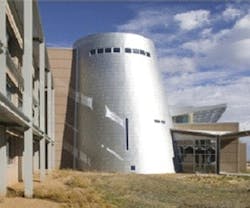It seemed like a pipe dream at the time. The federal government’s 2025 goal of building net-zero energy buildings – NZEBs, the feds dubbed them – came on a hot August day in 2008 when air conditioners nationwide were set at full bore. Yet the Net-Zero Energy Commercial Building Initiative (CBI), created to help meet the goals of the previous year’s Energy Independence and Security Act, already boasts some real progress in the form of successful case studies and ready-to-deploy building technologies.
In a nutshell, “NZEBs are grid-integrated buildings capable of generating as much energy as they consume through advanced efficiency technologies and on-site generation systems, such as solar power and geothermal,” according to Drury Crawley, former leader of the Building Technologies Program in the DOE’s office of Energy Efficiency and Renewable Energy. Aggressive deployment of NZEB technologies could save 8.5 quadrillion BTUs per year – equivalent to California’s annual primary energy draw.
So what are the main tools and design techniques that will precipitate this vast payback? Crawley points to the potential 30-50% energy savings at the engineered system level – lighting, heating, and cooling – as the first step for commercial buildings. Ultimately, these efficiency-oriented steps need to be supplemented by energy-producing technologies like photovoltaics to get to net-zero. But to set the stage for 2025, DOE leaders recommend starting aggressively with efficiency first.
To make the most of every opportunity, the Building Technologies Program has outlined a few key steps to follow
- Assemble a multidisciplinary team. Whether for retrofit or new construction, start with an integrated and collaborative project team of architects, contractors, engineers, end-users and maintenance staff.
- Practice whole-building design. The online Whole Building Design Guide (www.wbdg.org) has popularized this term, which basically demands that all components and systems be considered at once during the design phase, often starting with a full-team charrette.
- Set energy goals early. Specific, measurable targets for energy use should precede the design development phase. DOE offers 16 commercial reference buildings for 16 climate zones for benchmark purposes (see www1.eere.energy.gov/buildings/commercial_initiative/reference_buildings.html), as well as energy-use intensities and consumption tables and the Advanced Energy Design Guides with pre-computed paths to achieving 30% energy savings in certain building types.
- Model, model, model. Net-zero is hard enough to achieve, but it’s downright impossible without using simulation software to create an accurate energy model. To guide early-phase design decisions, use a software package such as EnergyPlus or the free OpenStudio plugin for Google SketchUp. Others include PC-friendly Energy-10 for small projects, and Radiance, UNIX freeware for lighting design and rendering.
- Lobby for commissioning and training. If the client is adamant about saving energy or getting to net-zero, go out on a limb and insist on serious facility commissioning, followed by training for maintenance staff and even occupants on how to use their energy-efficient and renewable energy technologies. In the use phase, the owner should also use standardized metrics to help measure, report, and evaluate energy performance.
After getting comfortable with the special mindset and approach behind NZEBs, design teams need a ready reference on the technologies to get you there. One place to start is perusing the 125 projects in the Building Technologies Program’s database (http://eere.buildinggreen.com). These case studies run the gamut from small shelters to multifamily residential to office towers and large education projects.
Glancing at a few of the case studies reveals that there are many ways to bake a zero-energy pie. Yet DOE experts suggest a few essential ingredients. First is a tight and durable building envelope – most likely using continuous exterior insulation, which is now referenced in ASHRAE’s energy standard 90.1. Cool roofs and exterior coatings, whether light-colored or reflective, also contribute to an efficient envelope.
With an increased emphasis on daylighting and views for building occupants in green ratings like the U.S. Green Building Council’s LEED program, another key focus for project designers should be windows and glazing. DOE is tracking novel heat-loss control and solar-gain control materials, including gas-filled panels and low-emissivity coatings. Advanced facade systems also automate the movement of shading and ventilation components on building enclosures.
The trend toward tighter building envelopes means that HVAC systems should regulate ventilation carefully, balancing fresh-air needs with energy recovery and other efficiency techniques. Novel lighting products on the horizon are expected to dramatically reduce consumption, too; they include LEDs as well as spectrally enhanced lighting, which uses color temperature to make every lumen count. For all engineered systems, integration and automation are the watchwords. The DOE points to advanced controls that go beyond typical building automation systems, as well as free energy sources such as geothermal heat pumps.
Which raises the most important direction for NZEBs: Net-zero demands tightly controlling system operations, yes, but our ability to capture solar, wind and earth energy will determine whether 2025 will truly herald a new age of super-low-impact buildings.
C.C. Sullivan ([email protected]) is a marketing communications consultant and writer specializing in architecture, design, and construction technology.
